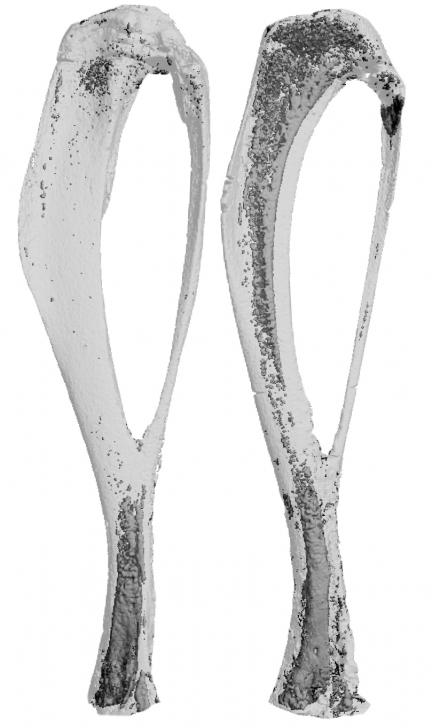You know why soup tastes good - and your dogs love it too. It's bone marrow fat. Now it may be healthier to eat delicious.
A study has found that the fat tissue in bone marrow is a significant source of the hormone adiponectin, which helps maintain insulin sensitivity, break down fat, and has been linked to decreased risk of cardiovascular disease, diabetes, and obesity-associated cancers.
Bone marrow adipose tissue has primarily been associated with negative health effects, most notably because of a documented relationship to reduced bone mass and increased risks of fractures and osteoporosis. The new study however – which included people with anorexia, patients undergoing chemotherapy, rabbits and mice – suggests that this type of fat may also have benefits.

Credit: University of Michigan.
"These findings are significant because we've found that bone marrow adipose tissue may have positive, protective roles, and influence adaptive functions outside of the bone tissue, at least during calorie restriction," says senior author Ormond MacDougald, Ph.D., the Faulkner Professor of Physiology at the University of Michigan.
"We know that low adiponectin has been correlated with multiple health problems and our findings suggest that an important source of this protein, and potentially others that we haven't identified yet, is the fat tissue inside bone marrow," adds co-lead author Erica Scheller, D.D.S. Ph.D., a
University of Michigan
postdoctoral fellow in the MacDougald lab.
Researchers have long studied the function of our fat, or 'adipose' tissue, in hopes of better understanding the link between obesity and ill health. One possible link is adiponectin, a hormone produced by adipose tissue that helps preserve insulin action. High levels of adiponectin are linked to decreased risk of diabetes and cardiovascular disease. People with obesity have the lowest levels of adiponectin – potentially increasing their risk for developing such diseases while the leaner someone gets, the more adiponectin they have.
An outstanding question in the field has been why adiponectin, which is produced by adipose tissue, increases as people lose body fat. A limitation in understanding this paradox is that previous research has focused on peripheral white adipose tissue, which has been believed to be the sole source of adiponectin.
The new study finds however that bone marrow fat tissue – which increases as body weight falls – is a previously unrecognized source of adiponectin during calorie restriction.
The study found that both marrow adipose tissue and adiponectin increased in humans with anorexia, and in patients undergoing chemotherapy or radiation treatment for ovarian or endometrial cancer. Researchers next used mice to study what happens when marrow fat formation is blocked and also found a relationship between bone marrow adipose tissue and adiponectin, indicating that fat tissue in marrow can have effects beyond the bone.
The research was performed with National Institutes of Health funding in MacDougald's laboratory at the U-M Medical School, and with collaborators including Clifford Rosen, M.D. of Maine Medical; Mark Horowitz, Ph.D., of Yale University, Anne Klibanski, M.D., of Massachusetts General Hospital; Susanta Hui, Ph.D., of University of Minnesota; and Venkatesh (Gary) Krishnan, Ph.D., of Eli Lilly and Company.
"Bone marrow adipose tissue has traditionally had a bad reputation because of its relationship to decreased bone mass but we now know that adipose tissue within marrow goes beyond the bone and also serves as an endocrine organ that can influence metabolism," says co-lead author William Cawthorn, Ph.D., a U-M postdoctoral fellow in the MacDougald lab.
"These findings really underscore how little we know about marrow adipose tissue, and also the mechanisms affecting circulating adiponectin levels. This is really just the beginning of much further research to better understand these relationships and their implications."
Source: University of Michigan Health System






Comments